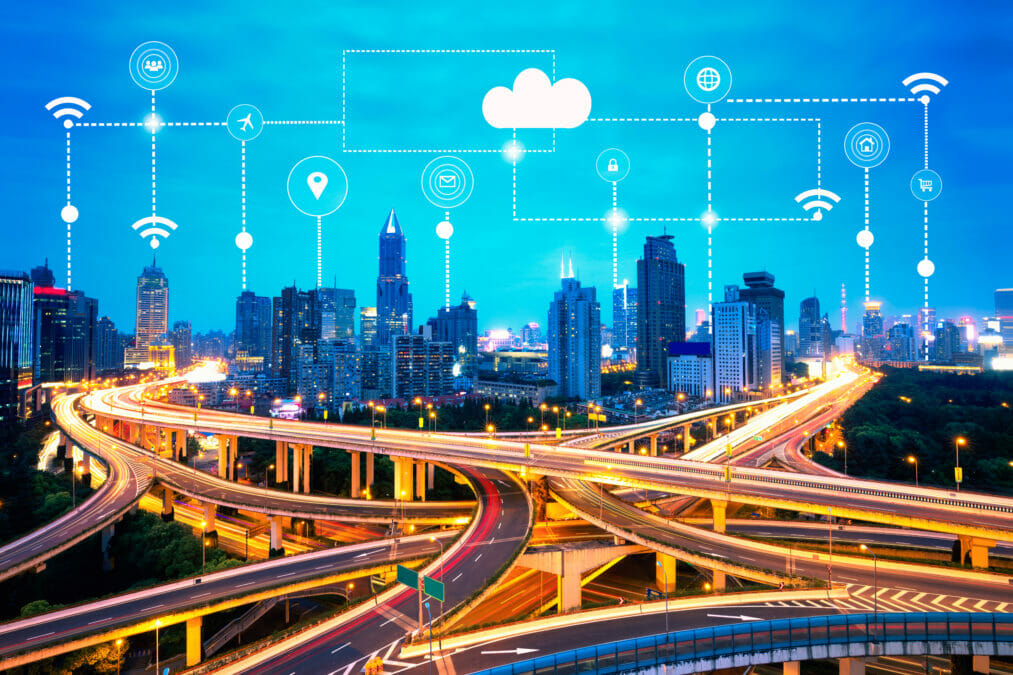It’s likely that you’ve heard the term ‘smart city’ mentioned if you work in technology. There are plenty of potential definitions of what smart cities entail, but common wisdom suggests it’s a city or municipality that informs, protects, and improves the experience for its citizens. Above all, they operate based on the swift acquisition and aggregation of data, the fast assimilation of this information into useful content and its real-time dissemination to stakeholders, leading to more informed decision-making. Based on this definition, our smart city journey is only just beginning; we’ve barely scratched the surface of what’s possible, and what this will make possible.
That said, various cities around the world are developing their strategies quickly, with the likes of Singapore, Dubai and Oslo leading the way. In the UK, the pandemic paired with Brexit have given government and businesses time to think, adjust, and plan their approach, with the emerging challenge of environmental, social, and governance (ESG), driving demand for practical solutions, with smart technology at the core.
Plenty of obstacles remain however, including three key considerations that must be tackled to make smart cities a reality.
How changing attitudes towards data sharing could boost smart city adoption
1. Taking data processing to the edge
5G has attracted considerable attention, but right now it’s not the primary technology used by many smart devices, and can be costly and technically challenging to deploy. That’s not to say 5G isn’t going to play an important role in future more complex deployments, especially for high bandwidth connectivity. However, relative to other technology, it is power hungry, and the majority of edge devices tend to be located where power is at a premium, and the applications require relatively low data rates to perform their function.
Smart cities will need scalable networks that deploy a hybrid of cost-effective technologies that can facilitate local processing of data in support of real time applications, and centralised collation of data within a remote data centre.
Edge technologies do exactly this. Edge processors collect data from multiple sensors positioned within a city’s key infrastructure. This could be offices, electricity substations, or transport systems, as well as wider industrial and defence settings, they then aggregate disparate information and quickly assimilate it into useful insights and valuable content. These insights can then be disseminated to key stakeholders as an action that will alert or better inform the recipient, or control and allow an automated event.
This is what we call “smart”, and is why smart city developers must prioritise edge technology – without edge devices, smart cities will simply not operate as required. Many are already looking to third party experts to provide the edge to core infrastructure that brings this disparate, structured and unstructured data together, and provide user with access to high value content.
2. Educating on data privacy and security to ensure user participation
Many smart systems require data to be validated and assimilated in real-time for it to be relevant. This poses a problem, in that it requires every citizen to agree to their data being collected and shared, which in turn requires trust. That means the collection of data and its use to influence critical decisions in smart cities, needs careful consideration.
However, citizens often worry about being ‘tracked’ – a difficult perception to eradicate in a world where privacy and security are among the biggest challenges each of us faces. Overcoming it requires us to build a comprehensive data privacy and security strategy into any smart city development, with local governments then responsible for educating individuals and society on how their data will be stored, who has access, and how it can be used.
Such strategies require careful consideration, as any mistakes that harm public trust could impact the success of smart cities. The NHS COVID-19 app is a good example of this – once people lacked trust in the application, it took only a matter of days for thousands of people to delete it. Once that happened, the data it collected became much less meaningful and representative.
Cyber security experts therefore have a key role to play in engineering security management systems that require the movement of data collected from “zero trust edge devices” onto secure IT platforms.
What are the best ways to ensure user privacy?
3. Tackling the question of ownership
Councils will naturally own technologies such as flood warning systems, and retain responsibility for other deployments such as intelligent and integrated traffic systems. The latter will also be heavily influenced by blue light services, which will need to be able to override red lights to ensure their progress when dealing with emergencies. Private enterprises and utilities will also have an increasing play in smart infrastructure as they look to anticipate footfall, EV charging requirements and demand for power. Hence, for a truly “smart” experience, data collected by public enterprises and authorities needs to be made available to all.
The problem, however, is that this only adds to the security conundrum. With so many invested parties, it may be difficult to communicate to society what is happening with individuals’ data and who has access to it.
On top of this, contemporary technology has a lifespan that doesn’t fit well within a long-term infrastructure investment, and its longevity is hard to predict, due to the relentless pace of innovation. At some stage, all smart technologies will need to be maintained, updated and replaced – but this needs to be funded from somewhere. So, there’s a big discussion to be had about responsibility and funding for these upgrades.
An innovative future
Recent smart city advancements are hugely exciting, and plenty of smart applications have already been deployed in our towns and cities. But a true smart city is one that operates seamlessly, using shared data in real-time, informing, predicting, and controlling outcomes for both consumers and suppliers. We’re not at that stage just yet.
First, we need to overcome some key obstacles, including prioritising the right technologies, educating society on security and privacy, and agreeing on ownership of smart infrastructure. Doing so will make it far easier to collect and aggregate data and achieve our aim of creating a valuable commodity – insights. These insights will be critical to increasing the operational efficiency and accuracy in how government, defence, utilities, and businesses operate and deliver their services in future, making smart cities a vision absolutely worth pursuing.
This is an exciting phase, and once these challenges are overcome, it won’t be long before all of us are living in cities that are optimised in every aspect of public life.











